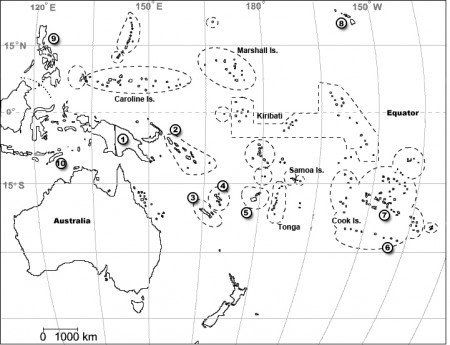- Transgenic American Chestnuts on trial, as it were.
- 1st International Symposium on Jackfruit and other Moraceae to take place 31 August-2 September. Don’t expect access to the papers if you can’t be there. h/t CFF.
- Breadfruit better than DEET at deterring mosquitoes. Tastier too.
- Crawford Fund opening up opportunities for coconut oil producers.
- History of the potato among the Basques. Well, why not?
- Microkhan disembowels the rat-meat trade of Mozambique.
Nibbles: Genomic data, Seed porn, Ancient Amazonian ag, Genebanks Down Under, Climate data porn, Fiber in Maine, REDD+ at the CBD, Colony Collapse Disorder, Chili porn, Seed systems
- GBIF makes its move.
- Homaging the seed.
- Learning sustainability from old Amazonian farmers. Really old. Really, really old.
- Yet another Aussie genebank. Or maybe the same one, I’ve lost track. And interest.
- Where climate data comes from.
- Maine’s fiber community, what, exposed? Unveiled? Uncovered? And similar from Bolivia.
- REDD+ will save us all.
- Don’t crack open the mead to celebrate the solution to colony collapse disorder just yet.
- All things Capsicum on one handy website.
- Whole bunch of policy briefs on African seed systems. Don’t know if I’ll ever have the time to read through the lot, but cursory perusal suggests the following bottom line: the market can’t do it all by itself.
Multidisciplinary taro book on the way
The National Museum of Ethnology in Osaka has just announced the publication of what promises to be a fascinating book on taro:
M. Spriggs, D. Addison and P. J. Matthews (eds) (2012) Irrigated Taro (Colocasia esculenta) in the Indo-Pacific: Biological, Social and Historical Perspectives (Senri Ethnological Studies 78). Osaka: National Museum of Ethnology. 363 pp., with index.
According to one of the authors, “[t]his map from the preface shows main geographical coverage (areas 1 – 10) of the volume (there is also some extension to China and mainland SE Asia).”

All the chapters will soon be available on the Museum’s website, so keep a lookout.
Nibbles: Domesticating fruit trees, Plains Indians, Weedy rice, Prize, Maize festivals, Ifugao, Bangladeshi diets, Pacific hopes, Plant patents
- Domesticating fruit trees for food and profit. But why the “scare quotes” around clone?
- Indians 101: Northern Plains Agriculture.
- A different kind of weedy wild relative; feral rice.
- Great, innovative agricultural scientist? Prizes await you.
- Mexico’s corn festivals celebrate diversity – but why bring opposition to GMOs into it?
- Project to help the people who created and manage the Ifugao rice terraces to cope with climate change. Stay tuned.
- Project to “diversify … diets to improve nutrition and incomes in Bangladesh”. Stay tuned.
- And countries of the Pacific look to crop diversity to manage climate variability. Stay tuned.
- Can a farmer commit patent infringement just by planting soybeans he bought on the open market? Good question; stay tuned.
Nibbles: Potaghurt, Yams, New fodder crops, Enset, Cowpea migrations, Trees
- Sweet potato and milk “potaghurt”. Just one way Ghanaian women gain from roots and tubers.
- Another way being through a US$12 million project “to boost yam productivity”.
- Dual purpose crops to sustain livestock and people in India.
- Qocho in Chicago. Calling enset “false-banana” doesn’t do it justice.
- Cowpeas came to Mexico from three separate continents, but is The Beaneater really eating cowpeas? Not necessarily.
- We need to see the trees for the woods, says a new book from ICRAF.